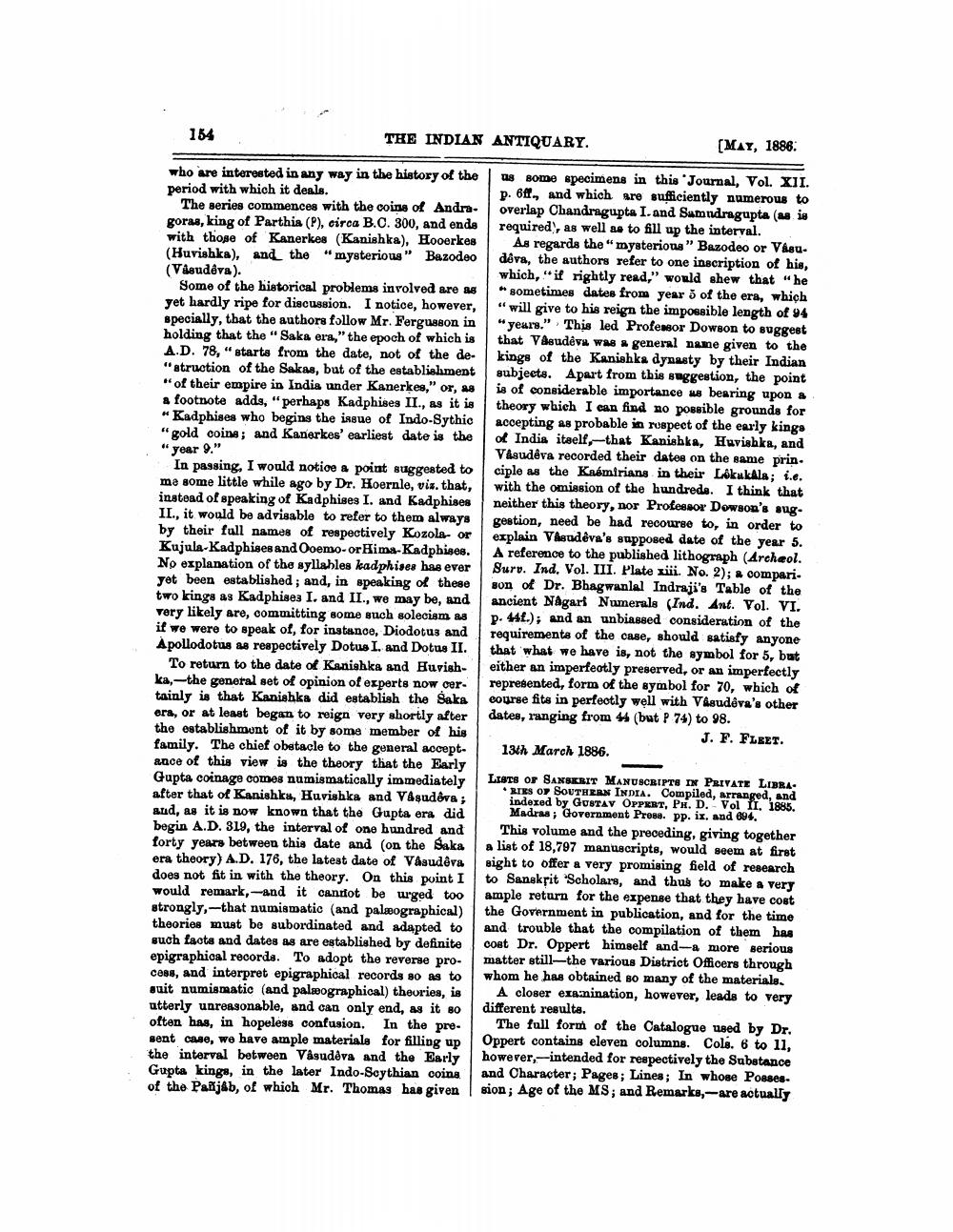________________
154
THE INDIAN ANTIQUARY.
[MAY, 1886
who are interested in any way in the history of the us some specimens in this Journal, Vol. XII. period with which it deals.
p. 6ft. and which are sufficiently numerous to The series commences with the coins of Andra- overlap Chandragupta I. and Samudragupta (as is goras, king of Parthia (), circa B.O. 300, and ends
| required), as well se to fill up the interval. with those of Kanerkes (Kanishka), Hooerkes As regards the mysterious" Bazodeo or Vasu. (Huvishka), and the mysterious" Bazodeo déva, the authors refer to one inscription of his, (Vasudêya).
which," it rightly read," world shew that "he Some of the historical problems involved are as * sometimes dates from year 5 of the era, which yet hardly ripe for discussion. I notioe, however, "will give to his reign the impossible length of 94 specially, that the authors follow Mr. Ferguson in "years." This led Professor Dowson to suggest holding that the "Saka era," the epoch of which is that Vasudeva was general name given to the A.D. 78,"starts from the date, not of the de- kings of the Kanishka dynasty by their Indian "struction of the Sakas, but of the establishment subjects. Apart from this suggestion, the point " of their empire in India under Kanerkes," or, 48 is of considerable importance we bearing upon a a footnote adds, "perhaps Kadphises II., as it is theory which I can find no possible grounds for "Kadphises who begins the ingue of Indo-Sythic accepting as probable in respect of the early kings "gold coins; and Kanerkes' earliest date is the of India itaelf,-that Kanishka, Huvishka, and "year 9."
Vasudeva recorded their dates on the same prin. In passing, I would notice a point suggested to ciple as the Kasmirians in their LékukAla; i.e. me some little while ago by Dr. Hoernle, viz. that, with the omission of the hundrede. I think that instead of speaking of Kadphises I. and Kadphises neither this theory, nor Professor Dowson's sugII., it would be advisable to refer to them always gestion, need be had recourse to, in order to by their full names of respectively Kozola- or explain Vasudeva's supposed date of the year 5. Kujula-Kadphises and Ooemo-orHima-Kadphiaes. A reference to the published lithograph (Archeol. No explanation of the syllables kadphises has ever Surv. Ind. Vol. III. Plate xiii. No. 2); « compari. yet been established; and, in speaking of these son of Dr. Bhagwanlal Indraji's Table of the two kings as Kadphises I. and II., we may be, and ancient Nagart Numerals (Ind. Ant. Vol. VI. very likely are, committing some such soleciam as p. 442.); and an unbiaseed consideration of the if we were to speak of, for instance, Diodotus and requirements of the case, should satisfy anyone Apollodotus as respectively Dotus I. and Dotus II. that what we have is, not the symbol for 5, but
To return to the date of Kanishka and Huvish- either an imperfeotly preserved, or an imperfectly ka,--the general set of opinion of experts now oer. represented, form of the symbol for 70, which of tainly is that Kanishka did establish the Saka course fits in perfectly well with Vasudeva's other era, or at least began to reign very shortly after dates, ranging from 44 (but P 74) to 98. the establishment of it by some member of his
J. F. FLEET. family. The chief obstacle to the general accept- 13th March 1886. ance of this view is the theory that the Early Gupta coinage comes numismatically immediately Lars OF SANSKRIT MANUSCRIPTS IN PRIVATE LIBRA
RIES OF SOUTHERN INDIA. Compiled, arranged, and after that of Kanishka, Harishka and Vasudeva;
indexed by GUSTAV OPPERT, PE, D. - Vol II. 1885. and, as it is now known that the Gupta era did Madras, Government Press. Pp. ix, and 894. begin A.D. 319, the interval of one hundred and
This volume and the preceding, giving together forty years between this date and on the Saka a list of 18,797 manuscripts, would seem at first era theory) A.D. 176, the latest date of Vasudeva sight to offer a very promising field of research does not fit in with the theory. On this point I to Sanskrit Scholars, and thus to make a very would remark,--and it cantot be urged too ample return for the expense that they have cost strongly,--that numismatic (and palæographical) the Government in publication, and for the time theories must be subordinated and adapted to and trouble that the compilation of them has such facts and dates as are established by definite coat Dr. Oppert himself and a more serious epigraphical records. To adopt the reverse pro- matter still the various District Officers through cess, and interpret epigraphical records so as to whom he has obtained so many of the materials. suit numismatic (and palæographical) theories, is A closer examination, however, leads to very utterly unreasonable, and can only end, as it so different results. often has, in hopeless confusion. In the pre
The full form of the Catalogue used by Dr. sent case, we have ample materials for filling up Oppert contains eleven columns. Cole. 6 to 11, the interval between Vasudeva and the Early however,-intended for respectively the Substance Gupta kinga, in the later Indo-Soythian coins and Character; Pages; Lines; In whose Posses. of the Panjab, of which Mr. Thomas has givension; Age of the MS; and Remarks,- are actually




